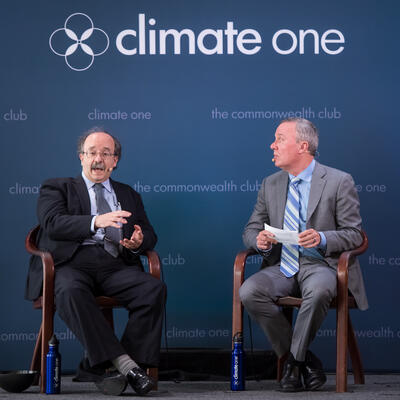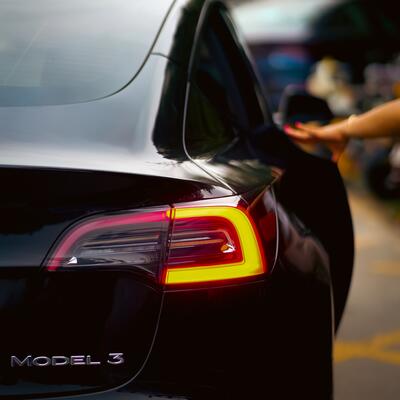
Amory Lovins: Peak Car Ownership
Guests

Amory Lovins

Emily Castor Warren

Gerry Tierney
Summary
Will the arrival of robotic cars lead to the blissful end of traffic? Or will they instead put drivers out of work and clog our streets more than ever before?
Amory Lovins, Co-founder and Chief Scientist, Rocky Mountain Institute
Emily Castor, Director of Transportation Policy, Lyft
Gerry Tierney, Associate Principal, Perkins + Will
This program was recorded in front of a live audience at the Commonwealth Club of California on April 12, 2017.
Full Transcript
Greg Dalton: From the Commonwealth Club of California this is Climate One, changing the conversation about America's energy, economy and environment. I'm Greg Dalton. The technology for self-driving vehicles is advancing with amazing speed with robotic test cars now plying the streets of several U.S. cities, automakers are scrambling to remake themselves as providers of mobility services. Governments are trying to figure out new rules of the road and crosswalks. Advocates of robotic cars say they will usher in an era of convenience and efficiency. Detractors cautioned against being seduced by techno-lust and warn they could lead to more gridlock and more carbon emissions.
With our live audience today we’ll explore the utopian and dystopian visions with experts on personal mobility. This conversation is generously underwritten by the ClimateWorks Foundation. Amory Lovins is cofounder and chief scientist of the Rocky Mountain Institute. One of the country's foremost energy experts. He's been advising corporations and countries for decades on the smarter use of power and technology. He’s the author of 30 books and has won the MacArthur genius award and many others. Gonna talk with Dr. Lovins for 20 minutes and then we’ll be joined by two other guests. Emily Castor, the Director of Transportation Policy at Lyft. And Gerry Tierney is an architect with the firm Perkins and Will. Please welcome Amory Lovins to Climate One.
[Applause]
Dr. Lovins let's think about Easter and you have a presentation where you show couple of photographs of an Easter parade. I believe it's New York City; one in 1900 and one in 1913. So describe those photos to us and what they mean for how quickly change can happen.
Amory Lovins: The Stanford innovation lecturer Tony Seba found these in the national archive. There are two pictures looking down Fifth Avenue in Manhattan. In 1900, you have to look really hard to find the first car. In 1913, you have to look even harder to find what might be the last horse and it’s not at all clear that there's any horse left in that picture. 13 years to go from first car to last horse.
And of course the horse and buggy people thought they would have decades to adapt. You'd have to put in gas stations and traffic lights and all this infrastructure to replace their staples and such. But Henry Ford simply made the Model T 62% cheaper in 13 years; not quite the same period. And then it was all over when GM and DuPont invented something called car loans which were used in three quarters of the purchases that made U.S. household car ownership go from 8% to 80% in 10 years through 1928, unbelievable. And what it shows you of course is that the pace of these transformations is set not by incumbents but by insurgents who don't care in the least about the incumbents legacy assets and business models and cultures. In fact, it can move even faster than that because capital flees before customers do. The capital markets keenly sniff out disruption. And if they think you’re in or headed for the toaster, they don’t wait for the toast to get done they just decapitalize you and invest in your successors. That's what's happening now to the oil and electricity industries.
Greg Dalton: And we have a clip we’re gonna show regarding that. Tesla’s skyrocketing stock has been making waves in the auto industry; clearly an insurgent. This recent news led to a spirited discussion about the merits of the company on the Fox Business News Network.
[Start Clip]
Male Speaker: Who would've thought that Tesla would come from nowhere and be more valuable than General Motors and the Ford Motor Company?
Female Speaker: I mean the Ford last month made nine times more cars than Tesla. Tesla has more than $2 billion in losses over the last five years.
Male Speaker: But you know what Peter Kiernan you put your finger on it. Tesla is not a car company. Okay they sell cars, what they really are a technology company.
Male Speaker: Technology company and look for them to make big steps into energy and battery, and other kinds of technology. They're building a huge plant to build batteries for their own car.
[End Clip]
Greg Dalton: That’s the Fox Business Network talking about Tesla and the disruption it’s bringing. That sounds fascinating, Amory Lovins but Tesla is still losing lots of money yet they seem to be, talk about this convergence of Silicon Valley in the auto industry.
Amory Lovins: It’s funny my hope had always been from coming up with the ultralight electric fusion called the Hypercar in ’91 that Silicon Valley would do it because I thought it would take that kind of culture to do it fast enough. So we did work and do work a lot with major auto companies, but they were not at that time culturally ready. So after a few years validation we actually put all our intellectual property in that into the public domain, so nobody could patent it got them all fighting over it. Now there are at least seven automakers hot on the trail of the transformation we described. And, you know, just the first seven years have leveraged our three million of charitably funded R&D investment into over $10 billion of industry commitments. So a lot of the acceleration of electrification hyperdrive, especially in Japan, new materials ultralight weight that stuff traces back pretty directly to that sneaky trick we did of treating it like Linux software, making it free.
Greg Dalton: But is Silicon Valley gonna eat Detroit's lunch?
Amory Lovins: Pretty good chance. And in fact the guy who led a lot of our work is now working for Apple on such issues.
Greg Dalton: Are they gonna make a car?
Amory Lovins: It seems pretty obvious they're going to make something interesting for mobility. And if you say working for the Apple car program they say what car program. If you just watch where people go, there’s obviously very serious efforts at Apple at Google or Alphabet and all the major auto companies around the world now have centers in Silicon Valley, trying to catch some of whatever they are spreading. This is a mash-up of mobility meets information technology. And it’s not just about for example, autonomous cars; it's not just about electric cars, but many, many elements coming together. And there are ways to at least four important ways to make electric cars happen a lot faster that are not even in the forecast. But the forecasts are stunning. You know, China in 2016 sold more electric cars than the world sold two years earlier. And China's five-year plan to help them with for 2015 to 2020 has a tenfold further increase in electric cars. They have of course policies supporting that. So if you buy a fueled car in smoggy Beijing, you enter a lottery where you have less than a 1% chance of winning, which means you're allowed to buy a registration.
If you buy an electric car, they’ll register it instantly for free. In Beijing, the license plate for a fueled car costs more than the small car you put it on. We don't have policies like that but a lot of countries are getting them. And in fact, now China and India, Germany, Holland are serious about targeting no more internal combustion cars made from 2030 onwards.
Greg Dalton: California tossed out a governor out of office once over raising licensing fees, that was 13 years ago, 14 years ago. You’ve talked about the industry of Henry Ford and Thomas Edison are converging. What do you mean by that? They used to be camping buddies 100 years ago there were electric cars then, fossil fuels dominated the first century, what's happening now?
Amory Lovins: Yeah, my grandmother had one of those electric cars. The first one with a crank window and she got her arms mixed up and cranked herself into a tree.
[Laughter]
Electric cars were for a little while more numerous than gasoline cars, which then zoomed ahead. And Edison was very clear that that was the way forward for propulsion. It took our modern automakers another century and a bit to come around that few. Ford was a different kind of industrial genius. They were good friends. If those guys on one of their car camping trips together were to wake up and see their industries today, they’d recognize everything except the electronics. But both these industries are undergoing fantastically rapid change and so is the oil industry that made the car industry possible. And basically Ford’s and Edison’s industry are getting together to eat Rockefeller's industry. They will be the end of the oil business along with other things that are happening in heavy vehicles industry.
So it's a very exciting time you can kind of imagine Ford whispering to Edison and I found a picture of him whispering at Edison’s ear at the Ford Museum so I put this on as an imaginary bubble, “Gee, I can’t wait to see what will happen when our industries merge” and that's now what's happening. Because, you know, oil and electricity had nothing to do with each other less than 1% connected, less than 1% of our oil made electricity, less than 1% of our electricity was made from oil. But as soon as you take the biggest oil user, autos, and electrify it to displace the gasoline, then a number of important things happen. You make batteries cheap because you make so many of them. Then you have distributed solar all over the place. You also have these giant batteries on wheels plugged into the grid, making it easier for the grid to accept varying solar and wind power. You get the idea it's one of the major steps in getting off fossil fuel.
Greg Dalton: But is this a happy marriage, are utilities happy to be married to auto companies? For a long time it's been Detroit and Houston had this kind of alliance. One made the fuel, one made the cars.
Amory Lovins: But they really didn't like each other.
Greg Dalton: That's true. They would say that now, but how about utilities, electric utilities and cars. They have to put in these plugs everywhere are they gonna make more money doing it?
Amory Lovins: Well, electric demand in the U.S. has been drifting down for a decade, along with oil demand. And nice thing about charging electric cars is they can charge smart just when there's say night wind power and surplus. So they can actually hook up very nicely with renewables to advantage and give the utilities a more even load and make sure that their renewable power all goes to good use.
Greg Dalton: But so far a lot of the car companies, the electric cars they've made have been to satisfy regulators in California so what they’re marketing there’s what, twenty something cars out there with a plug. But they are still a tiny percentage of sales; do you think that's going to change?
Amory Lovins: Yeah, it’s changing very rapidly and the one indication of why policy matters is that in Norway a third of the new cars are electric which is 50 times the U.S. share. Now one-way they do that the most important is called a feebate, when you buy a new car, you pay a fee or get a rebate; which and how big depends on how efficient it is. Electric cars are extremely efficient. So basically you avoid very large purchase taxes for electric cars in Norway. There are other ways to speed up electric cars. You can make them two or three times lighter and more slippery so you need two or three times fewer batteries because they need two or three times less energy to run them for the same range. So that saves a lot of money.
Greg Dalton: And you’ve been talking about that for decades. Are car companies doing it, are there carbon fiber cars out there today besides the BMW i8 --
Amory Lovins: Yeah, I drive one.
Greg Dalton: -- that cost about a quarter million dollars or something. Can you go buy one?
Amory Lovins: Yeah, there’s a couple on the market. One limited-edition from Volkswagen 235 miles a gallon for a two-seater and the one I drive is a BMW i3. I just saw another one out on the street here and that's a 124 miles a gallon, carbon fiber electric cars that came out in 2013 and it’s the best car I ever had. And in fact, they confirm as we had claimed since ’91 that the carbon fiber is paid for by needing fewer batteries. And then of course when you have fewer batteries that it charges that much faster; you get a whole spiral of nice benefits.
So there are these two technological changes of ultralight and electrification coming together but then there are also three big changes in business model. And you mentioned one, autonomous cars; that's the furthest off but there's two that are all over the place right now. One of those is car sharing, everything from Getaround to Zipcar, and the other is a mobility as a service like Lyft and Uber. And now those are starting to come together on your mobile device, as public and private transport firms open up their code so you can see where all the vehicles are and meld all of the offerings and pick the one you want. We’re doing this actually as pilots in Austin and in Denver and it's very exciting; it solves the last mile problem. And it's already clear that even the early, the model year 2018 electric cars will be about a thousand bucks a year cheaper to own and operate than a conventional equivalent car.
Greg Dalton: Most people don't consider operating costs. They look at the sticker price, right?
Amory Lovins: Yeah, but the fuel cost is many times lower. And if you're in a high asset utilization business model that is if a car drives a lot of hours a day instead of just one hour a day that quickly overwhelms any initially higher sticker price that grows to a $4000 advantage over the next decade or so per year.
Greg Dalton: We have cheap gas now and Americans are buying bigger cars.
Amory Lovins: Of course, and they’re heavily marketed because they're much more profitable.
Greg Dalton: And now Detroit has gone to Washington asking to slow down the increase in the fuel efficiency standards. How much can the new administration change this transition that you're talking about by favoring fossil fuels, letting Detroit build more larger cars which Americans love we all love them let’s admit it.
Amory Lovins: Oh I think they could make some policy mistakes that would be very harmful to the car industry and that seems to be the way they're headed. Why harmful to the car industry? Well, I just did a piece in Forbes giving about eight reasons for that. One is that the rest of the world although significant markets have very strict car efficiency standards. Do you really want to make dumb cars for here and smart cars for export? That doesn't sound like a very bright idea if you’re a global manufacturer. You’re stomping on your own innovation, which means that the talent you're trying to poach from Silicon Valley they'll have a lot better luck poaching from you. Just look back at what happened to GM when they stomped on their EV1, which was a terrific vehicle. But it contradicted their lobbying position so they got rid of it and found it much harder to attract the kinds of people they needed.
And of course this industry plans a very long time ahead it's enormously complicated to make something with about 14,000 parts working very reliably for about 15 years and sell it for cheaper per pound than a Big Mac but that’s what they do, they’re just amazing at what they do. So now you introduce a lot of uncertainty. Gee, are we gonna go after the California waiver that lets it about dozen other states set stricter standards. Well that'll be litigated for years; chances are California will win but meanwhile you don't know what you're going to be making. And the whole effort to renege on previous deal that unified all three regulatory regimes split it up so they aren’t unified anymore and try to weaken some, that will be litigated for years. This industry can't afford that kind of uncertainty so, you know, be careful what you wish for.
Greg Dalton: Yeah, the lawyers often call the shots in the auto companies. I want to talk about supply and demand of fossil fuels and renewables. They move in different directions in different ways. So explain to us how supply and demand work differently for fossil energy and renewable energy.
Amory Lovins: Oh well, fossil fuel, particularly oil prices have been fluctuating since about 1859. They're perfectly random like any commodity, they go up because they went down before, they go down because they went up before. And if you don't like it, don't buy the stuff. If you buy renewable energy that's constant price for decades you know exactly what you're getting so it's much less risky and risk is cost.
Also, Seba points out a very basic difference. Your next oil well makes my next oil well more expensive. Your next solar panel makes my next solar panel cheaper because it's not depleting an oil resource. It's building volume in a mass-produced manufactured product. It's a completely different deal; technology and geology are not the same thing. And that's why the cost of solar panels has dropped about 80% in five years and keeps dropping. In fact, it is getting so ridiculous in the rate of change some of the cheapest solar power in unsubsidized markets is being bid in Mexico. There was a period of about eight or nine months last year in which the Mexican photovoltaic price fell 37%.
And during that same less than a year, the price of European offshore wind power, the next big thing coming in renewables, fell 43%. Whatever forecasts you do about renewable price are going to be obsolete before the ink is dry.
Greg Dalton: So when we buy more renewable power the price goes down. When everyone in this audience puts solar on their roof the price goes down. When we buy more gasoline, the price goes up.
Amory Lovins: Ultimately, yeah. It fluctuates a lot but the general trend is up.
Greg Dalton: If you’re just joining us, we’re talking with Amory Lovins, cofounder of the Rocky Mountain Institute at Climate One. I'm Greg Dalton. We’ll be back after this.
[CLIMATE ONE MINUTE]
Announcer: And now, here’s a Climate One Minute.
Advances in automotive technology make it easier than ever to have a fossil-free commute. But what if we didn’t need cars at all? Transportation advocate Jeff Hobson says that there are plenty of options for getting around town – including bike sharing. But, he adds, it’s important to make sure that those options are available to everyone.
Jeff Hobson: To me, bike sharing is part of the whole universe of having lots of options. That's what you really need to do to be able to live a full vibrant life without a car. U.S. cities were mostly built with the assumption that most people would have a car, and we are in the process of reconstructing our cities, rebuilding how we live our lives in ways where we don't have to have a car.
And I think it's really important with bike share, as well as all of these other sharing kind of apps and services that are coming into existence; we need to make sure they work for everyone. And too often, when these services start, they start being pitched at the high end of the income scale. And that's something that we need to fix. That's something that public policy has a lot to do with, whether it's bike share, you make sure that you have pods in low income communities, that you make sure that you do outreach in places, not just in Starbucks, but you do them in the communities where we want to make sure that they get used. So that's an important part of bike share as well as the other sharing economy.
Announcer: Jeff Hobson of the transportation advocacy group TransForm joined us in 2015. Now, let’s get back for the second half of our program on peak car ownership. Here’s Greg Dalton.
[END CLIMATE ONE MINUTE]
Greg Dalton: We’re joined now by Emily Castor, Director of Transportation Policy at Lyft. Emily previously worked as a congressional staffer and is a financial advisor to municipal infrastructure projects. We should also note that General Motors is an investor in Lyft and a sponsor of the Climate One podcast. Gerry Tierney has been an architect for 30 years and an associate principal at the firm of Perkins and Will. He has collaborated with university researchers studying the disruption of the auto industry and given talks at Stanford and elsewhere on cities and autonomous vehicles. Please welcome them to Climate One.
[Applause]
So Emily Castor, we’re talking about the world, American cities with robotic vehicles. Is this gonna add to congestion or alleviate congestion in American cities?
Emily Castor: That seems to be the question that everyone's asking right now. I think, you know, everyone sees this technology on the horizon perhaps coming even faster than we all would expect and yet there are so many questions about the impacts. And I think a consensus that started to emerge from a lot of experts in academia and the policy sphere in the last 18 months or so is that the question of whether these vehicles will create congestion and emissions or whether they will reduce them will into a large extent be determined by whether they are personally owned or whether they are shared. And I obviously have an investment, you know, a reason to believe in that viewpoint because I work at Lyft which is a platform for shared transportation. But it stands to reason that essentially if you take a vehicle that is capable of piloting itself and have it be owned by just one person that there’ll be a lot of other opportunities for sort of extraneous mileage and inefficient use of that vehicle if it's solely dedicated to that one person who only needs it a little bit of the time and would be inclined to let it, you know, drive around empty, perhaps circling the block.
Amory Lovins: Or you send it out to buy a six-pack.
Emily Castor: Exactly. Exaggerating the current inefficiencies of personal car ownership if that were the ownership model versus a scenario in which the vehicles instead are being highly optimized by a network being filled with as many passengers as possible picking up other individuals when one person isn’t using them and thereby finding ways to potentially reduce vehicle emissions, vehicle miles traveled and therefore congestion. So the question of whether or not they’re shared or owned may be a fulcrum on which that question rests.
Greg Dalton: So it could go either way. Gerry Tierney, how is this gonna affect the cities we live in? The world is urbanizing, more people are living in cities, are the roads going to be more parking on the street or the streets gonna become parking lots?
[00:32:09] Gerry Tierney: Well I think following on from what Emily has just said about the ownership, that's going to be key because I think our future has to based on a shared electric motor connected vehicle. And if we look at the utilization of current vehicles, lot of the people out here in the audience we own a car and you figure out what is your utilization. The average utilization of a vehicle privately owned vehicle right now is between 4% and 5%. It means that one of the biggest investments that you own is sitting idle for 95%, 96% of the time. And this --
Greg Dalton: Depreciating there.
Gerry Tierney: Depreciating there as well while we’re at it. So the notion of having something like an autonomous vehicle being sitting around going out and buying you a six-pack or going and getting you a pizza being like your little personal valet is quite clearly a very dystopian kind of picture. And kind of like conjures up image of anybody remember the Pixar animated movie Wall-E and there they were on their big starliner the Axion going around with their Slurpees and like Barcaloungers, that could be potentially one of the futures.
We want to create a vision of like what is the alternative on that. And then based on a shared autonomous vehicle we then invert now the efficiency so that that vehicle has been utilized 95% of the time it's going in for servicing, battery charging the other 5% of the time. That's great. What else, what are the other advantages though that an autonomous vehicle can bring us.
Number one, we've gotten rid of parking because you basically turn up at the front door and it drops you off and it goes off and it picks up other passengers and whatever. So you can start thinking of curbside parking becomes a thing of the past. We start looking at parking in buildings as being a thing of the past. And before you raise your hand and said how can you have large buildings without parking. The city of San Francisco right now in the downtown district, Rincon Hill around the Transbay where you see the large high-rises going up, they do not require any parking. They have parking maximums not parking minimums. And they’re still building those high-rises, they’re selling those high-rises. Now how can they do that?
Another item downtown there was a billboard up near the one of the new high-rises called LUMINA and it was from Audi. And it was saying, if you moved into the LUMINA, they basically give you a subscription to Audi. And Audi would valet, in other words they would bring you the vehicle you wanted. So if you wanted to go up to Tahoe they bring you an SUV. You want to go up the coast and, you know, you got a hot date or something they give you a sports car. If you have to go down and visit the in-laws in Bakersfield or Fresno they give you a four-door sedan. So what's called rightsizing vehicles because the majority of trips in vehicles are below 3 miles with a single occupant. But yet we all drive around in a four-door sedan.
So now we start rightsizing vehicles. We have the autonomous lanes can get narrower the headway between them if they’re in a platoon formation means the amount of real estate that these vehicles takes up is shrunk. And right now we are working on collaborative studies with Arup, an engineering firm you may well be familiar with. And we are currently doing studies where we’re showing that we can take urban four-lane streets for travel lanes and bring that down to two travel lanes and still maintain the throughput. So when you think of we've now removed two travel lanes, we've removed the parking lanes along the side, we freed up that space. So this is an efficiency of the street. If we leave it to the traffic engineer what he’ll say is, great you've increase the efficiency by a hundred percent.
So that means I can double the number of vehicles going down my street or we could invert that and say no, the throughput of the street right now is perfectly fine; we are in the city after all, we aren't entitled by some constitutional right to drive at 45 miles an hour down the city street. But we start giving that space over to the people. We start giving it to the sidewalks, we start giving it to pedestrians to cyclists to people riding scooters to whatever to rainwater gardens treating storm water out in the street. All of those things. But this discussion needs to happen with the general population and not just leave that discussion with the traffic engineers.
Greg Dalton: Amory Lovins, are the car companies going to sell fewer cars in this future, where they - and are they gonna therefore fight it?
Amory Lovins: Well, it depends. If they are ahead of the game as some of them are in developing mobility services they like this future of leasing mobility services in which the car is not a source of revenue on which they didn’t make much anyway, excuse me, from selling the car. Instead it’s a source of steady leasing revenue and the cheaper the car is the less cost they have in the leasing business.
On the other hand, if they’re stuck in the old commodity model of just moving the metal, the more cars the better, they will be seriously disappointed. Because the U.S. is probably going to have peak car ownership according to a new analysis we just published about three years from now.
Greg Dalton: And what does that mean, peak car ownership, meaning that --
Amory Lovins: You can’t count on vehicle sales going up. They’re going to start turning over and going down just like gasoline sales have for the past decade.
Emily Castor: And part of the reason for that really is through the household economics of what this is gonna look like once autonomous vehicles become available on a shared platform basis. Because today if somebody in a suburb or a city is deciding whether it make sense for them to own a car or to try to rely on alternative transportation options they're looking at how much each of those things cost and kind of comparing the cost profile. And today, especially if you live in a suburb, a place where transit isn't readily available it's probably cheaper to own a car because, you know, Lyft has a certain cost that’s baked in that's required to compensate the driver. There are probably aren't a lot of other transit options that are available in that kind of a suburban environment and so people choose car ownership. But in the future when autonomy makes it possible for Lyft to offer reliable transportation on demand at a much lower price, that will democratize access to that service and make it suddenly much more financially attractive for the average consumer to make that decision and to be able to count on that transportation being available to them in a way that they've never been able to count on transit and really have that be the no-brainer choice. So we’re gonna hit a tipping point when that happens.
Amory Lovins: Well, already if you’re living in the city you can save about $10,000 or $11,000 a year by not owning a car and using the integrated on your device public and private transport services along with biking, walking get around. And you just put all the pieces together and suddenly it seems pretty nutty to own a car and many younger people don't want to own a car anymore.
Greg Dalton: Gerry Tierney, is now a good time to sell the parking garage if I own one?
Gerry Tierney: [Laughs] Yes. Well, I think we have to start looking at the parking. I know we’ve actually have a couple of clients of ours who own parking garages are about to build large parking structures. So this is actually a very current topic of ours. To give you some background, we work on large master plan like projects. We did the master plan along with SOM for Treasure Island for instance. We’re working with San Francisco Giants on lot A and the development down there we’re looking at other ones around the Bay Area. And so we’re looking at projects that would have a build out horizon of around about 25 years, 25 years from now. I mean designing large parking structures and designing our roads and everything for the current set up of cars is a bit like kind of at the turn of the 19th century and the 20th century designing exclusively horse stables for cars and you can see, you know, a little car going down the street. We know that things are going to transition.
So parking structures we’re looking out perhaps using them for two things. One as a strategic way of land banking because we might be in a situation where we can see the parking garage does not make sense at a certain location. Let’s say it’s near a railroad station. It does not make sense to build right there right now a high density eight-story, ten-story building. We’re thinking of this for instance, with high-speed rail in California where you’ve got certain cities where the downtowns are being rezoned. It makes sense to put density right by the station. Right now the market isn’t there for density but there is a market for cars. So we build the parking structures there but we build them so they could be demountable. You can basically kind of downsize them as the market goes away and then recycle these parking garages.
We’re actually looking at doing parking garages in all in wood, in solid lumber or laminated lumber because wood is a very good recyclable material for instance. So that's one thing that we’re looking at.
Greg Dalton: Lego maybe?
Gerry Tierney: Play-doh?
Greg Dalton: Lego, no.
Amory Lovins: Well that is you think about new urbanist design kind of thing that Peter Calthorpe pioneers. You end up with about a third less concrete and two thirds less driving for the same throughput. If you design the city around feet, not tires; that is, you, you integrate and distribute where people live workshop in place so they don't need to go very far nor by car. And suddenly, instead of vast arterial networks for cars you have a capillary mesh or web for people. Some may be in cars on one way, some maybe in bus rapid transit, a lot will be in walking or biking but they won't need to go very far to get where they want to be most of the time. And they'll end up with a much more vibrant social fabric and commerce, it's a real neighborhood re-created that's the way cities always grew organically before we let the traffic engineers design them.
Gerry Tierney: So we’re in a stage right now of a transition stage. I mean right now we can kind to see that we’re moving out of one paradigm which is been governed by the automobile into a new paradigm which we don't fully understand, but we know it's going be considerably different. So how do we manage and future proof our projects for this new paradigm to arrive. And that’s what we’re doing in this transition period and that will go on until --
Emily Castor: And it’s already really starting to happen in the way that transportation agencies and planners think about the way they use their curb space. I mean for the first time we’re starting to see planners coming to us, even property owners, and saying how can we think differently about how we allocate that space along the curb?
Maybe it doesn't make sense for us to have that all chopped up into single-use parking spaces where vehicles are gonna sit idle for hours at a time. Instead, maybe we can creatively redesign that to be, you know, a pickup and drop off zone for Lyft vehicles next to a bike parking space and a parklet and really craft a much richer variety of human uses of that space that can take advantage of the sort of much higher throughput that comes along with shared transportation when you're not just parking hunks of metal there.
Greg Dalton: If you’re just joining us we’re talking about the future of mobility in American cities at Climate One with Emily Castor, Director of Transportation at Lyft. Amory Lovins, energy guru and cofounder of the Rocky Mountain Institute and Gerry Tierney, an architect with Perkins and Will. I'm Greg Dalton.
In New York City, there are 150,000 taxi drivers. One longtime taxi driver talked to us about the rise of robotic cars and how the potential to threaten his job and others.
[Start Clip]
Victor Salazar: My name is Victor Salazar. I have been driving a taxi since 1993. I’m also an organizing committee member of this organization the Taxi Workers’ Alliance.
The taxi drivers are facing a very tough situation because driverless car could actually replace us as drivers or force us to be only part time drivers. We’re not against technology but we’re against the use of technology and hopefully will not be used as an instrument of oppression in the future.
The robots will not do the same job like we will do because when an individual comes to my cab, I talk to them, I make them laugh. I can see that the person maybe a little sad, I make them a couple of jokes. We talk about politics; we talk about a lot of things we can talk in the car with the driver. The robots will not be able to do so. Why trying to do this just to enrich certain companies and taking away the jobs of individuals, the full time jobs of taxi drivers are at stake over here. What got into the politician, what’s wrong with people not accepting the reality that we deserve a full time job? That’s the American dream.
[End Clip]
Greg Dalton: That’s New York taxi driver. Emily Castor, jobs, killing the American dream.
[Laughter]
Emily Castor: So this is an emotional issue. It's something that this transition of automation coming to our economy certainly not just in for higher transportation. Not even just in passenger transportation, not even just in the transportation field. Automation is something that is going to ripple across our economy and is already doing so in many, many industries and we have to take that seriously. From a policy perspective, we need to be investing in the way we prepare people for a 21st century economy. You know, that being said, the for hire transportation industry, taxis, limos those traditional services. Yes, they have been a large part of the transportation ecosystem in a place like New York City, but you look across the rest of the country and it's actually tiny because these types of services in the past without the benefit of technology without the benefits that automation will bring in terms of making it more affordable for people have not been able to be incorporated into people's daily commute patterns and actually become a replacement for the private automobile. What we’re trying to do is actually something much, much larger to bring on-demand mobility into places where it has never existed.
And frankly the people who are gonna benefit the most from that are the people who have been underserved by transportation options in the past who can't afford to live in the center of cities anymore where now it's become very expensive. And those are the places where transit, traditional transit can be viable. We need as an economy to bring the benefits of affordable technology-based transportation to solve those mobility access challenges that millions of Americans face and actually improve their access to jobs. And I think there's a huge potential for economic opportunity there but it's not gonna come without the need for policies to address the transition in our labor force.
Greg Dalton: Gerry Tierney, there’s another piece of that New York City taxi driver who said the loss of humanity and there’s a human and social aspect to this where the loss of robots replacing humanity. And there's also a sociological aspect to when we cross the street there’s a lot of human interaction going on. Eye contact with drivers, how do you make eye contact with a robotic car? There’s a whole human part of this that’s, let’s get into that.
Gerry Tierney: Yeah, that’s a fascinating conversation to have. And I'm certainly not kind of putting down the concerns of the taxi driver. But just going back, I think it's false dichotomy to have this as a zero sum that we have an autonomous future therefore, the people's jobs are threatened.
The people's jobs are going to evolve there’s gonna be a transition period. I think the taxi drivers are people that strive in these vehicles, your drivers, for instance, and Lyft and Uber at some point they transition to something else. So I think we need to start a discussion dealing with the reality of the situation. People are going, the market is going to move towards people wanting to have an autonomous vehicle, a shared environment that would just arrive. And I think we have to start looking at alternative jobs for the workers that are going to be displaced acknowledge that will happen. But you bring up the point of the humanity. For instance, I was coming over here today and it was a Lyft ride and I had the most fascinating conversation with the driver about autonomous vehicles of all things. Why? Because we turned around the corner and there was one of the Uber Ford Fusion autonomous vehicle right in front of us so we had this great conversation.
So not only do you get a great ride from Lyft but a fascinating 15-minute discussion with the driver. When we move into an autonomous environment and the vehicles interacting with humans that is something which is probably one of the great kind of like technological barriers that they're confronting right now. Because right now when we come to a four way stop, there's the body language of the other driver telling us whether they want you to move or you go on. And that doesn't happen with an autonomous vehicle they are very rigid stick to the rules and kind of almost freeze. So they have not kind of gotten that ability for the autonomous vehicle to interact with the humans. Having said that though, I think they will get a protocol there. How? I have no idea, I'm not a programmer.
Emily Castor: And from a sociological perspective, let’s keep in mind that actually I think we can get people to start to have more shared experiences through this. Because today, what most people are doing is sitting alone in a car by themselves driving it, right. Most people are in this very isolated my car is my castle kind of a commute experience. And what we’re doing with Lyft already even before automation is actually getting people to carpool.
We are with our Lyft Line shared ride option now over 40% of people in the cities where we offer that choose to share their ride with someone else. Sometimes there are 2, 3, 4 people filling up those cars.
Greg Dalton: Gerry Tierney.
Gerry Tierney: I was gonna say, I’m not sure if it’s an urban myth Emily but, you know, the story about like with Lyft, people by and large always get in the front seat and sit in the passenger seat alongside the driver. Where if you call an Uber, you always get in the back seat and you treat it like a taxi. So I’m not sure if it appeals to different parts of our brains and our moods and things like that. So I think Lyft is the convivial, the social kind of world and things like that maybe the taxi drivers would same does kind of like these entertainment, stand-up comics or sit-down comics in these autonomous vehicles to keep us entertained.
Emily Castor: Oh and there will be individuals who will require assistance. As we see the elderly individuals with disabilities, children who require transportation. As fewer and fewer people own their own cars, they’re gonna need to have service-based models for delivering that type of transportation service as well. So there will be new categories of jobs and not economy.
Amory Lovins: Emily I have a dumb question which comes from Robin Chase. You know she cofounded Zipcar and is one of the leading thinkers in this area. And she's worried that if we don't, along with autonomous vehicles develop road pricing, then for example, Amazon would put out mobile warehouses using the free road space to circulate around carrying the hundred most popular items with the promise to deliver it to you two minutes from your order.
Emily Castor: Yeah, I think the case is clear that we need to apply economics to the way that we price the allocation of road space. So Lyft as a company already uses dynamic pricing for our own service. And the reason we do that is to make sure that it's always available, right. So that nobody ever gets stranded because even during a peak time we can make sure a car will be there. But we’re not doing the same thing with our roads; it always cost the same, even if you're using it at a peak time when everyone wants to use it which is why you can end up getting stuck in traffic that's bumper-to-bumper.
So when you look at some of the creative uses of lane pricing like in L.A. on the 110 Freeway or many other places around the country, Northern Virginia. They now have hot lanes, these kinds of smart lanes where they apply tolls that change depending on whether it's a peak time or an off-peak time and encourage people to carpool because you can save money and get a faster travel time that way and also generate a source of revenue for transportation infrastructure. That clearly seems like the way that we need to go to manage demand to encourage high occupancy use of cars and also to provide a replacement for the gas tax.
Gerry Tierney: Yeah, I think this is a huge thing about, you know, the notion of vehicles going around kind of strategically waiting to serve you with their whatever it is at Amazon. And we really started looking, this is an idea that came from Jeff Tumlin and Nelson Nygaard we need to be having a seat tax or rather a zero seat tax. That if your autonomous vehicle has nobody in it, it’s basically charged at the highest rate; that there is a kind of disincentive to have nobody in there. And if there's only one person, comes down a notch and basically the more people you put in there, the more your kind of taxes go down. And this would come to a kind of a policy, we’re gonna have to come to a fork in the road for we disincentivize the single occupant or the zero occupant vehicle if we don't outright forbid it. And I think that is a major toggle between our utopia and our dystopia because this is gonna lead us into a shared autonomous vehicle world or just the Wall-E world we were describing.
Emily Castor: Right. Well I mean I think it’s also important to understand how businesses optimize the use of assets versus individuals, right. So I think I would actually be a lot more worried about private individuals, consumers owning cars and then not really thinking about how much it cost them to have it be running around with nobody in it when they're not using it than I would about Amazon or businesses. Because I can say from a Lyft perspective we’re very aware of the cost to us of under efficiency in the system. We want any vehicle on our platform to be filled with as many people as possible and to have as little dead time as possible in between each use, because any sort of inefficiency comes right out of our pockets. Whereas historically individuals have been much less good at realizing how those costs add up which is why people don't really realize how expensive car ownership is in the first place.
Greg Dalton: We’re gonna go to our lightning round we’re talking about future of mobility with Gerry Tierney an architect. Amory Lovins, energy visionary and leader of the Rocky Mountain Institute cofounder and Emily Castor from Lyft. I’m Greg Dalton.
Greg Dalton: Okay, this is true or false. Starting with Amory Lovins. Flying cars will be commercially available during your lifetime?
Amory Lovins: Well, I'm about 70 let’s see. False. And if you love congestion in two-dimensions you’ll love it in three-dimensions.
[Laughter]
Greg Dalton: True or false. Amory Lovins, robots are being tested today that will deliver hot food to the homes of San Francisco residents?
Amory Lovins: Probably true.
Greg Dalton: It is true. It is true. Robots have a human escort on the street but that's another story. Emily Castor, if the auto industry had listened to Amory Lovins 25 years ago, we would all be driving cooler cars today?
Emily Castor: True, obviously.
Greg Dalton: Amory Lovins, ride hailing companies such as Uber and Lyft should share their data with researchers more fully so we can find out if they really increase or reduce traffic congestion?
Amory Lovins: True, but there a lot of other reasons that would be beneficial for everybody.
Greg Dalton: Gerry Tierney. True or false. Architects can make more money advancing the utopian vision of robotic cars than the dystopian vision?
Gerry Tierney: False.
Greg Dalton: Amory Lovins, technology consultants can make more money advancing the utopian vision of robotic cars than the dystopian vision?
Amory Lovins: Probably false. Yeah, interesting.
Greg Dalton: Well you can point on that one. Last one for Gerry Tierney. True or false. Driverless vehicles will compete with cheap motels because they will be a convenient place to hook up?
[Laughter]
Gerry Tierney: True.
Greg Dalton: Okay that ends our lightning round. Let’s give them a round of thanks.
[Applause]
We’re talking about the future of mobility at Climate One. Let’s go to our audience questions.
Male Participant: Thanks for a great discussion. My question is about mobility for people who have been underserved on mobile market. You touched on the issue a bit maybe with regards to elderly or the disabled. Lots of folks that are doing, you know, that are older shouldn’t be driving and certainly car sharing seems like an opportunity to help.
Greg Dalton: Thank you. Emily Castor.
Emily Castor: Absolutely, this is already starting to happen. So, if you look at the way that older folks get around or individuals with disabilities get around historically, it's first of all been very, very limiting, right. There are a lot of people who are isolated who don't have access to the mobility that they need, whose family members can't serve them. And so we’re really trying to create something that will help them and part of the way that we’re doing that is partnering with the communities where these individuals live with senior living communities, also with medical organizations and nonprofits. And we’ve created ways to allow those organizations to dispatch ride, get those people picked up without the person ever needing to have a smartphone themselves. We’ve even partnered with the company that makes that special smartphone I think it's called the Jitterbug for folks who had really large buttons and you can press one it'll call an operator and allow that person to dispatch a Lyft vehicle to come get you.
So there are creative ways the technology is being repurposed for those communities to try to make it more accessible for them. And then I think there's also the broader picture of how Lyft can work with public transit in the future and how public transit changes. Because public transit serves a vital function in ensuring that mobility is available for everyone and yet they've been very limited in the tools in their tool belt for a long time.
Greg Dalton: Let’s go to our next audience question. Welcome.
Female Participant: Hi, Mandy Econ [ph] with the Natural Resources Defense Council, two quick questions. One, if so much rides as Emily as you're saying on this question of shared versus private ownership, what can cities, states, policymakers do to encourage that shared future, as opposed to the vehicle ownership future.
Second question, there are a lot of conflicts coming up in cities with the rise of the TNC as a transit rider as a cyclist. We haven’t figured out yet where these things should go, how they pick you up, how they drop you off, buses are often honking at them to get out of the way. Should cities plan for block by block accommodation of TNCs now? Are we in the middle of an evolution so that it doesn’t make sense for them to make infrastructure changes now, when we’re not anywhere near sort of the end state.
Greg Dalton: Thank you. Gerry Tierney.
Gerry Tierney: Well, I don’t know whether you wanted to answer the -- I’ll answer the second question there. Was really a two-part question, and yes, I think that the cities do need to start right now. And in fact they really are, you know, behind the scenes we’re having these conversations. They understand the whole curb management the whole notion of curb management and how we accommodate the Lyfts and the Ubers dropping off instead of just double parking in front of a row of parked cars. And I think that you're going to see over the next couple of years a lot of kind of design guidelines coming out. There’s NACTO guidelines and hopefully they will be changed to reflect these modifications to the street infrastructure to accommodate a kind of a shared environment that allows bikeways to go through that allows buses on the bus stops and then allows curbside pickup and drop off. What you are going to see is the gradual removal of on street parking and I think those, we’re at the very baby steps right now. So I think if you kind of come back in a couple years’ time you'll see more kind of hard guidelines around that topic.
Greg Dalton: Emily Castor.
Emily Castor: Yeah, and I think those questions are actually very closely linked. Because one of the most powerful things that cities can do to help encourage shared transportation is changing the way that they allocate their space. As a city transportation agency that's really what you have to control. It’s how you allocate and price and prioritize the use of your road lanes the use of your curb space. And so, you know, it may be expensive to make infrastructure changes, but paint is cheap. Why not experiment to take a kind of prototyping approach in the spirit of tactical urbanism, right. These experiments that we’ve started to see in the last several years of painting over places that used to be big car intersections and turning them into plazas. We can do that with street parking as well, paint it over, turn it into creative pickup and drop off spaces for shared mobility and see how it goes. See if that can actually improve the access for pedestrians for cyclists and for shared vehicles and then paint back over it and do it a different way if it doesn't work out. And that I think is something that's important to do during these periods of rapid transition to make sure that we can adapt quickly as the technology changes.
Greg Dalton: Lots of exciting changes coming our way. Let’s go to our next audience question.
Male Participant: Hi, my name is Daren. I liked a lot of what I’ve heard in terms of bus rapid transit, designing city streets for feet and not tires. But it seems to be based on the assumption that we need to switch to ride sharing or way for technology. What are some of the barriers and solutions for U.S. cities to get us doing things like Copenhagen and Amsterdam and Muenster are doing in terms of getting people on the street, biking, walking, active transit.
Greg Dalton: Gerry Tierney, how to get American cities more like, you know, people on bikes today, rather than having these long term changing the concrete in our cities which we know takes a long time and is expensive.
Gerry Tierney: Yeah, and this is a really good question. And in San Francisco we’re starting to see that with a better Market Street program which is in the process of being implemented but that will be a hard infrastructure improvement. I think Emily touched upon it earlier when she said using the bucket of paint. And this is the example of the people are familiar with Times Square, Herald Square in New York, where the first prototyping of that was consisting of taking paint and lawn furniture and whatever they could find at the department of roads and transportation in New York and simply started painting out Times Square and reconfiguring that.
And looking at how successful it was and then taking that model down to Herald Square and again that was successful and then spreading throughout all of the boroughs of New York. And I think what we need to do and Emily touched upon this is we need to start taking this out and trying things out.
Greg Dalton: Emily Castor, last word?
Emily Castor: Yeah, I think one of the things that we haven’t talked about that I considered the most interesting is the way that these all converge, right. So how can we actually catalyze this shift towards shared transportation and maybe get to some of those more ambitious kinds of policies. I mean part of the way that and how can we make sure that those vehicles are all electrified. It's because when these technologies come together each of them make the others work better. You know, we didn't spend as much time in this conversation on electric vehicles as you might've thought. But we talked early on today about how hard it's been to get people to buy electric cars and how, you know, the models that have been put out there in the past, you know, whether you can argue whether they've been marketed heavily enough. But Americans have only bought them, you know, a couple percent of the total consumption in the country.
Well, what’s going to massively change is that as people shift away from owning them toward accessing them on a shared fleet. All of a sudden the economies of scale of operating electric cars are gonna be unlocked by companies that are operating these autonomous vehicles. They're going to be able to capture the fact that it's so much cheaper when you're doing many thousands of miles per month to be able to operate an electric car instead of a fuel car. And that is gonna it’s gonna catalyze a shift that will reduce emissions for each mile that are driven on these platforms that’ll put more people in those vehicles and to wean them off of that model of personal car ownership that has resulted in this particular set of design characteristics in American cities. And once people fundamentally change that behavior you will see an openness I think toward different types of street designs that people haven't been open to in the past when they felt like they had no options other than owning and driving a car.
Greg Dalton: And one other person might say that we’ve been talking about it still a very car-centric future. There’s another school of thought out there that cities ought to get away from cars altogether more on bikes. And this is just replacing one car-centric city with another car-centric city.
We’ve been discussing the future of American cities in the era of robotic cars. I’m Greg Dalton and my guests on the show today were Amory Lovins an energy leader and cofounder of the Rocky Mountain Institute, Emily Castor, Director of Transportation Policy with ride hailing company Lyft and Gerry Tierney, an architect working on the impact of robotic cars on cities. You can hear our podcast of this and other Climate One programs by going to our website or wherever you podcast. If you do, please rate the podcast and leave a comment. To our audience in the room and online and on radio, thanks for joining us as we change the conversation about America's energy, economy and environment. Thanks you all for coming.
[Applause]
[End]







